| Lime | |
|---|---|
| | |
| Hex triplet | #C0FF00 |
| sRGB B (r, g, b) | (192, 255, 0) |
| HSV (h, s, v) | (75°, 100%, 100%) |
| CIELChuv (L, C, h) | (93, 111, 106°) |
| Source | RGB color system |
| ISCC–NBS descriptor | Vivid yellow green |
| B: Normalized to [0–255] (byte) H: Normalized to [0–100] (hundred) | |
Lime is a color that is a shade of yellow-green, so named because it is a representation of the color of the citrus fruit lime. It is the color that is in between the web color chartreuse and yellow on the color wheel. [1] Alternate names for this color included yellow-green, lemon-lime, lime green, or bitter lime. [2]
Contents
- Usage
- Variations
- Key lime
- Lemon-lime
- Arctic lime
- Peridot
- Volt
- Electric lime
- French lime
- Web color "lime" (X11 Green)
- Lime green
- Bright lime
- See also
- References
- External links
The first recorded use of lime green as a color name in English was in 1890. [3] [1]
Lime (color hex code #C0FF00) is a pure spectral color at approximately 564 nanometers on the visible spectrum when plotted on the CIE chromaticity diagram.
yellow |
lime |
chartreuse |











